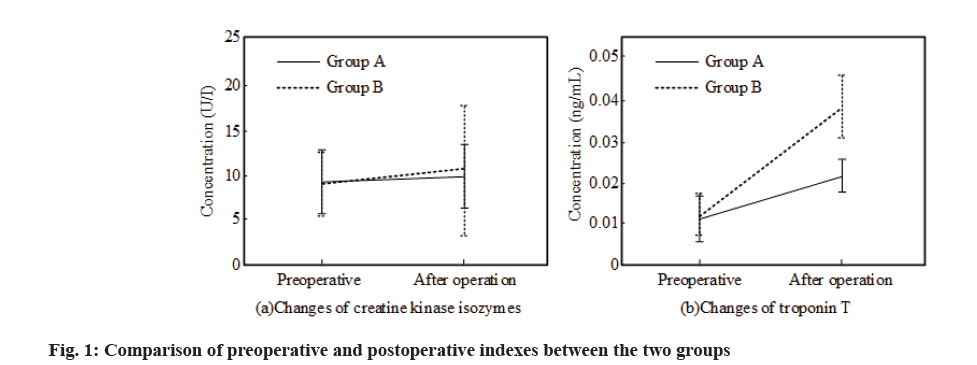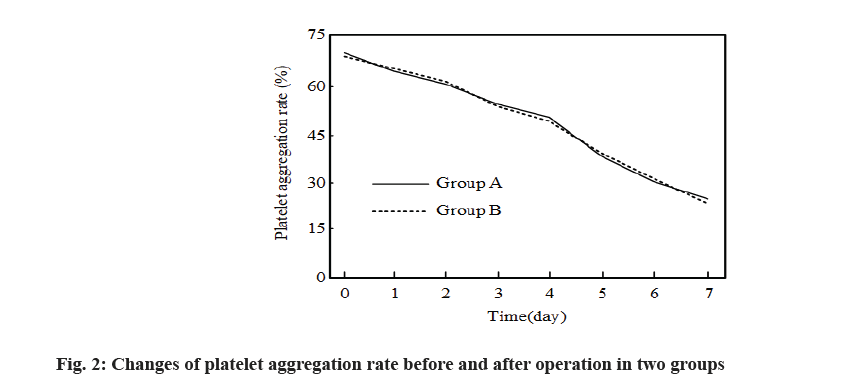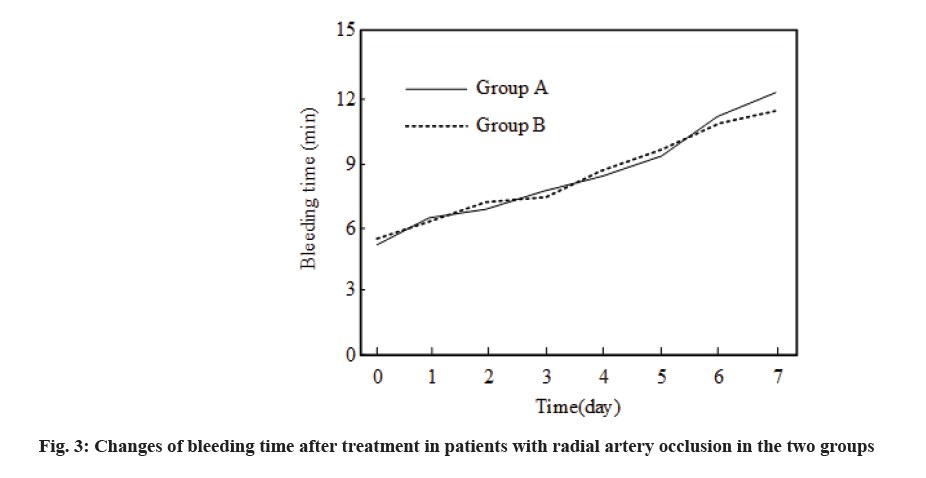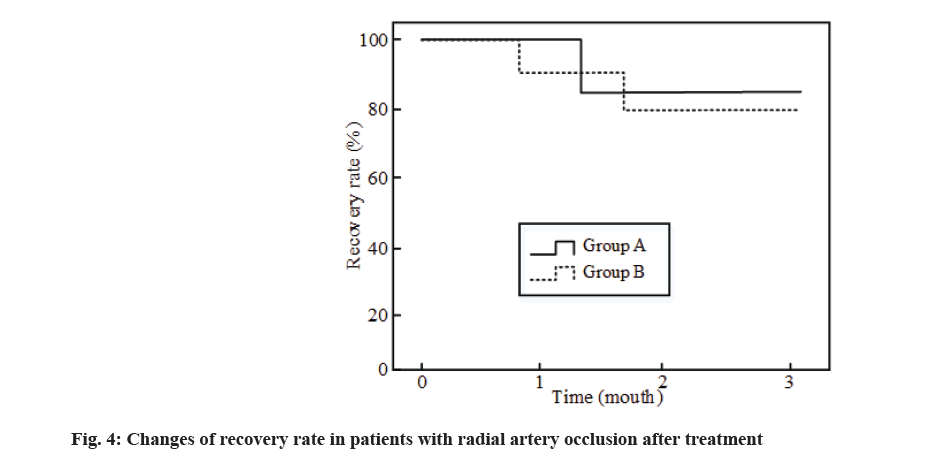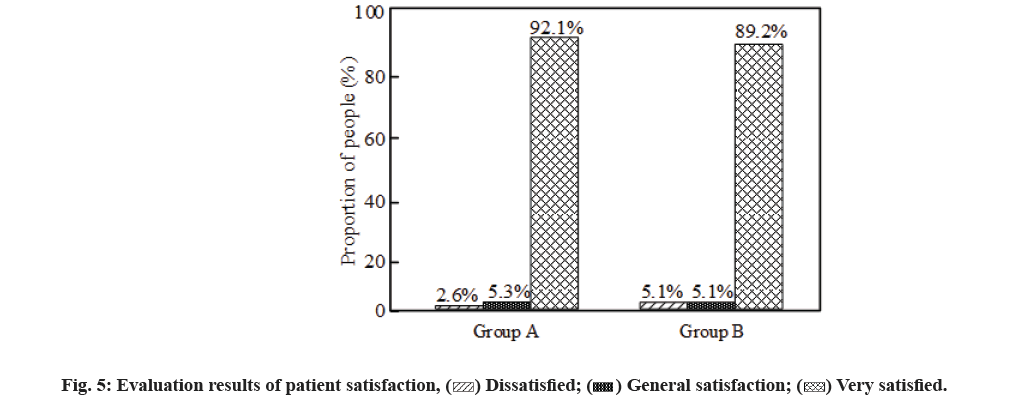- *Corresponding Author:
- Yize Wang
Department of Cardiovascular Medicine,
Yiyang Central Hospital,
Yiyang,
Hunan 413000,
China
E-mail: xiaxing18507378819@163.com
| This article was originally published in a special issue, “Trending Topics in Biomedical Research and Pharmaceutical Sciences” |
| Indian J Pharm Sci 2022:84(1) Spl Issue “92-99” |
This is an open access article distributed under the terms of the Creative Commons Attribution-NonCommercial-ShareAlike 3.0 License, which allows others to remix, tweak, and build upon the work non-commercially, as long as the author is credited and the new creations are licensed under the identical terms
Abstract
To investigate the effects of anticoagulants and antiplatelet drugs on radial artery occlusion after coronary intervention through radial artery is the objective of the study. A total of 77 patients who underwent coronary intervention in our hospital from June 2018 to December 2020 were selected. The patients were divided into group A and group B according to the difference of anticoagulants and antiplatelet drugs used. Two groups of patients underwent transradial coronary intervention, observed the levels of creatine kinase isozyme and troponin T before and after operation, analyzed the effects of anticoagulants and antiplatelet drugs on patients with radial artery occlusion and finally discussed the curative effect of patients with radial artery occlusion after treatment. The levels of creatine kinase isozyme and troponin T increased to a certain extent after coronary intervention through radial artery, but they remained in the normal range. The average use of antiplatelet drugs in patients with radial artery occlusion was significantly lower than that in patients without radial artery occlusion and the difference was statistically significant (p<0.05). Under the influence of anticoagulants and antiplatelet drugs, the postoperative bleeding time of all patients was significantly improved and the difference was statistically significant (p<0.05). Anticoagulants and antiplatelet drugs have an impact on patients with radial artery occlusion after transradial coronary intervention. When the dosage of the two drugs is small, it is easy to cause radial artery occlusion and the frequency of using anticoagulants and antiplatelet drugs for radial artery occlusion is gradually increasing and can be used in follow-up treatment for patients with radial artery occlusion.
Keywords
Anticoagulant, antiplatelet drugs, coronary intervention, radial artery occlusion
With the wide application of clinical interventional diagnosis and treatment, the complications associated with traditional femoral artery puncture are becoming more and more obvious. After years of clinical practice, it is gradually found that coronary intervention through radial artery has a simpler operation mode while reducing bleeding complications than femoral artery approach. However, it is inevitable that there are still common complications such as radial artery occlusion [1,2]. Since then, studies have proposed that anticoagulants and antiplatelet drugs play an extremely obvious role in inhibiting thrombin activity and platelet activity. Therefore, in the follow-up of clinical treatment, the frequency of using anticoagulants and antiplatelet drugs for radial artery occlusion is gradually increasing, but the mechanism of action is not clear. That is, it is not clear what role anticoagulants and antiplatelet drugs play in the treatment of patients with radial artery occlusion in addition to reducing thrombin activity and platelet activity [3-5]. In view of this, this study will analyze the postoperative radial artery occlusion of patients undergoing coronary intervention through the radial artery and observe the changes of various indexes under the influence of anticoagulants and antiplatelet drugs in order to provide theoretical support for the control of complications after clinical transradial coronary intervention.
Materials and Methods
General information:
77 patients who underwent coronary intervention through radial artery in our hospital from June 2018 to December 2020 were selected, including 45 male patients and 32 female patients, with an average age of (63.9±17.2) y.
Inclusion criteria: Patients who meet the indications of coronary intervention and choose to undergo transradial coronary intervention; the age range is 18~85 y old; the functions of heart, lung, liver, kidney and other important organs were normal.
Exclusion criteria: Female patients are pregnant or lactating; the patient is intolerant or allergic to anticoagulants and antiplatelet related drugs; patients had contraindications to anticoagulation or hemorrhagic diseases; patients suffer from diabetes or hypertension. The patient has a history of alcoholism or drug abuse.
All included patients were aware of the experimental process and content, signed the informed consent, and obtained the consent of the ethics committee of our hospital.
Research methods:
One day before coronary intervention via radial artery, the patients were randomly divided into two groups: Group A and group B. There were 38 patients in group A and 39 patients in group B. In group A, dalteparin was used as anticoagulant and aspirin and clopidogrel were used as antiplatelet drugs and in group B, the anticoagulant was limaiqing, and the antiplatelet drugs were aspirin and dipyridamole. Before operation, all patients were ensured to take the antiplatelet drugs corresponding to their group. After successful arterial puncture, patients in group A were injected intrathecally with dalteparin through radial artery and patients in group B were injected with limaiqing. According to whether there was radial artery occlusion in the two groups after operation, subgroup analysis was carried out to analyze the situation of patients in groups A and B in the occlusion group, and the situation of patients in groups A and B in the normal group.
Observation indicators:
The patient’s gender, age and other basic information were recorded at admission. The patient’s preoperative platelet count and coagulation function test showed that the platelet count was <100×109/l which indicates that the patient has abnormal conditions. The platelet aggregation rate induced by drugs was detected after operation and the bleeding time was measured. The platelet aggregation rate was measured by platelet aggregation instrument and the inducer was adenosine diphosphate. According to the previous standards, the evaluation method of bleeding time is the time from skin bleeding to natural stop. The bleeding time is detected by bleeding time tester. Clean filter paper is used to suck the blood that does not contact the skin every 30 s. The normal range of bleeding time is 4.8~9.0 min. The levels of serum creatine kinase isozyme and troponin T were detected before and after operation, and the changes of creatine kinase isozyme and troponin T were observed before and after operation [6-8].
Statistical analysis:
All the data in the experiment were statistically analyzed by Statistical Package for the Social Sciences (SPSS) 22.0 software. The measurement data were expressed by mean±standard deviation (x??s), in which the data conforming to the normal distribution were tested by t-test and the data not conforming to the normal distribution were tested by rank sum test. The counting data are expressed as percentage or number of cases and the data are analyzed by chi square test, p<0.05 showed that the data difference was statistically significant.
Results and Discussion
Table 1 shows the comparison results of general data of all patients. The table shows that there is no statistical significance in gender, age, body mass index, smoking history and other baseline information of patients in groups A and B (p>0.05), it shows that the two groups of patients can be compared and analyzed. There was no significant difference in the number of patients with radial artery occlusion between the two groups (p>0.05).
| Project | Group A | Group B | t (χ2) | p value | |
|---|---|---|---|---|---|
| Gender | Male | 20 (52.6 %) | 23 (59.0 %) | 1.462 | 0.521 |
| Female | 18 (47.4 %) | 16 (41.0 %) | |||
| Age (years) | <45 | 18 (47.4 %) | 17 (43.6 %) | 0.074 | 1.021 |
| ≥45 | 20 (52.6 %) | 22 (56.4 %) | |||
| Body mass index (kg/m2) | 25.462±2.372 | 25.593±2.977 | p | 0.189 | 0.851 |
| Smoking history | Yes | 15 (39.5 %) | 19 (48.7 %) | 0.667 | 0.414 |
| No | 23 (60.5 %) | 20 (51.3 %) | |||
| Radial artery occlusion | Yes | 6 (15.8 %) | 10 (25.6 %) | 1.135 | 0.287 |
| No | 32 (84.2 %) | 29 (74.4 %) | |||
Table 1: Comparison of General Data Between the two Groups (n %, x?±s)
Changes of various indexes in the two groups were compared. Fig. 1 shows the comparison results of creatine kinase isozyme and troponin T levels before and after operation between the two groups. It can be found that in group A, the average level of creatine kinase isozyme in postoperative patients increased by a certain amount compared with that before operation, but the difference was not statistically significant (p>0.05). From the change of troponin T level, it can be seen that the level of troponin T in group A after operation is significantly higher than that before operation. After comparison, the difference is statistically significant (p<0.05). From the comparison of patients in group B, the levels of creatine kinase isozyme and troponin T were increased to a certain extent compared with those before operation, but there was no significant difference in the same creatine kinase isozyme (p>0.05), the difference of troponin T level was statistically significant (p<0.05). A. There was no significant difference in the levels of creatine kinase isozyme and troponin T between the two groups before and after operation (p>0.05).
Table 2 shows the comparison results of radial artery occlusion in the two groups. It can be found that the number of radial artery occlusion in the two groups is significantly less than that without radial artery occlusion. From the comparison within the group, the dosage of antiplatelet drugs in patients with radial artery occlusion in group A was significantly lower than that in patients without radial artery occlusion, the difference was statistically significant (p<0.05). Similarly, the amount of antiplatelet drugs taken by patients with radial artery occlusion in group B was significantly lower than that of normal patients and the difference was statistically significant (p<0.05). Table 2 shows that in groups A and B, the preoperative anticoagulant injection volume of patients with postoperative radial artery occlusion was 4000 International Units (IU), while the anticoagulant injection volume of patients without radial artery occlusion was 5000 IU and in 31 patients. It can be seen that 83.3 % of patients with postoperative radial artery occlusion in group A were 4000 IU. In group B, the number of patients with radial artery occlusion reached 80.0 % and the number of patients without radial artery occlusion injected with 5000 IU anticoagulant accounted for 93.0 %. It can be seen from the information in the table that there is no statistically significant difference in the dosage of anticoagulants affecting radial artery occlusion between groups A and B (p>0.05).
| Project | Radial artery occlusion | Normal | χ2 | p | |
|---|---|---|---|---|---|
| Antiplatelet drugs | Group A | 151.5 mg/d | 307.3 mg/d | 1.264 | 0.002 |
| Group B | 146.5 mg/d | 311.2 mg/d | 1.684 | 0.001 | |
| Anticoagulant drugs | Group A | 4000 IU (5) | 5000 IU (31) | 0.025 | 0.874 |
| Group B | 4000 IU (8) | 5000 IU (27) | 0.025 | 0.874 | |
Table 2: Comparison Results of Radial Artery Occlusion between the two Groups
Fig. 2 shows the comparison results of preoperative and postoperative platelet aggregation rates between the two groups. It can be seen that the average platelet aggregation rate of group A patients before operation reached 69.91 %. After the inhibition of antiplatelet drugs, the average platelet aggregation rate of group A patients after operation decreased to 26.03 %; the average platelet aggregation rate in group B was 69.27 % before operation and 24.36 % after operation. There was no significant difference between the two groups (p>0.05), however, the change of platelet aggregation rate in the group was statistically significant (p<0.05).
Treatment effect of two groups of patients with radial artery occlusion was compared. Fig. 3 shows the bleeding changes of patients with radial artery occlusion in the two groups after operation. The figure shows that with the increase of time after treatment, the bleeding time of patients in group A is also increasing, which is significantly greater than that before treatment, the difference before and after treatment is statistically significant (p<0.05). The bleeding time after operation in group B was also significantly improved compared with that before operation and the difference was statistically significant (p<0.05). In addition, comparing the differences between the two groups, it can be found that there was no significant difference in bleeding time between the two groups before treatment (p>0.05), However, it can be seen that the difference in bleeding time after treatment is statistically significant (p<0.05).
Fig. 4 shows the long-term recovery survival curve of two groups of patients with radial artery occlusion after treatment. It can be seen from the figure that among the patients in group A, the recovery of patients with radial artery occlusion after drug treatment is better. During the patient follow-up survey, one patient had recurrence in the first half mo and the relevant doctors carried out follow-up treatment in the process. In group B, two patients recurred within 3 mo during the recovery time. During the follow-up, relevant doctors also carried out follow-up treatment and the patients got good results in the follow-up treatment. According to the information in fig. 4, in the treatment of patients with radial artery occlusion with antiplatelet drugs, the overall recovery rate reached more than 80 %.
Fig. 5 shows the comparison results of the satisfaction evaluation of the two groups of patients in the treatment process. It can be seen that the two groups of patients are highly satisfied with the operation process and subsequent treatment. 92.1 % of the patients in group A are very satisfied with the treatment process and 89.2 % of the patients in group B are very satisfied with the treatment process. In general, the total number of very satisfied patients accounted for 90.9 %. There was no significant difference in the number of patients with the same satisfaction between the other two groups (p>0.05).
Table 3 shows the adverse reactions of the two groups during postoperative observation and treatment. The table shows that there is no thrombosis in the two groups and there are no serious adverse bleeding reactions such as gastrointestinal bleeding and intracranial bleeding. Gingival bleeding occurred in both groups, 4 cases in group A and 2 cases in group B. However, the difference in the number of adverse reactions between the two groups was not statistically significant (p>0.05).
| Project | Group A | Group B | χ2 | p value |
|---|---|---|---|---|
| Thrombus | 0 (0 %) | 0 (0 %) | / | / |
| Gastrointestinal bleeding | 0 (0 %) | 0 (0 %) | / | / |
| Intracranial hemorrhage | 0 (0 %) | 0 (0 %) | / | / |
| Gingival bleeding | 4 (10.5 %) | 2 (5.1 %) | 0.781 | 0.377 |
| No bleeding | 34 (89.5 %) | 37 (94.9 %) |
Table 3: Comparison of Adverse Reactions of Patients (N, %)
Transradial coronary intervention is a new technology proposed to solve the problem of coronary artery stenosis. Because of its simple operation and high surgical safety, it is gradually and widely used all over the world. With the continuous improvement of medical technology, the number of patients receiving interventional therapy is also increasing [9,10]. In longterm clinical practice, it is found that coronary intervention through radial artery can reduce the difficulty of doctors and avoid most postoperative complications, but serious complications such as radial artery occlusion are still difficult to eradicate. The clinical manifestations of radial artery occlusion are mainly the disappearance of radial artery pulsation and the decrease of skin temperature. The blood supply to the hand will be seriously affected. Therefore, it is very important to treat radial artery occlusion in time. Many studies have found that anticoagulants have a good effect in inhibiting thrombin activity. Under the action of anticoagulants, the blood coagulation rate decreases and the bleeding time increases [11-13]. In addition, some studies have proposed that the use of antiplatelet drugs will reduce the time of thrombosis and have a certain effect on the treatment of arterial occlusion [14]. Therefore, based on the clinical effects of anticoagulants and antiplatelet drugs this study was applied to patients undergoing coronary intervention through radial artery to explore the effects of anticoagulants and antiplatelet drugs on postoperative radial artery occlusion.
In the study, the patients were divided into group A and group B according to the use of different anticoagulants and antiplatelet drugs. After comparison, the serum creatine kinase isozyme and troponin T in the two groups were increased to a certain extent after coronary intervention through radial artery. The test results show that there is no statistical significance between the two groups, but it can also be clearly seen that the changes of the two indexes before and after operation are different, which indicates that the differences of anticoagulants and antiplatelet drugs will also have a certain impact on the postoperative performance of the patients. From the intra group changes of the two groups, there was significant difference in the levels of creatine kinase isozyme and troponin T before and after operation. However, the levels of creatine kinase isozyme and troponin T remain within the normal range after operation. According to previous studies, after coronary intervention, the two indexes will exceed the normal range, resulting in arterial occlusion [15,16]. However, according to the results of this study, it can be seen that anticoagulants and antiplatelet drugs can prevent patients from radial artery occlusion to a certain extent. This result can also be verified from the number of patients with radial artery occlusion after operation. The number of patients with radial artery occlusion in the study is relatively small.
In addition, according to the detection of platelet aggregation rate before and after operation to analyze the application effect of antiplatelet drugs, it can be seen that the platelet aggregation rate of the two groups of patients has been significantly reduced, which shows that the platelet activity of patients after receiving antiplatelet drugs has been inhibited. The comparison results between the two groups show that antiplatelet drugs will affect the change of platelet aggregation rate, that is to say, different antiplatelet drugs have different effects on platelet activity. The above research results are consistent with previous relevant reports [17].
After analyzing the situation of postoperative radial artery occlusion in the two groups, it was found that compared with normal patients, the preoperative antiplatelet drugs and intraoperative anticoagulant injection of patients with radial artery occlusion were significantly lower than those with radial artery occlusion. According to relevant reports, the preoperative dosage of antiplatelet drugs generally needs to reach 300 mg/d, but the preoperative dosage of patients with radial artery occlusion in this study is lower than this standard [18,19]. In addition, some studies have pointed out that the amount of anticoagulant injection in preoperative preparation is also a key factor to determine the thrombin activity of patients [20]. It can also been found from the study that patients with small anticoagulant injection have a higher probability of postoperative radial artery occlusion. For patients with radial artery occlusion after operation, antiplatelet drugs were used for treatment and the bleeding time after treatment was improved, which changed significantly compared with that before treatment. It also further shows that antiplatelet drugs can prevent radial artery occlusion. Finally, according to the satisfaction of patients with water surgery and follow-up treatment, almost all patients have an ideal medical process and the complications are less and mild, which is consistent with the contents reported in previous studies [21].
In conclusion, anticoagulants and antiplatelet drugs have a great impact on radial artery occlusion after percutaneous coronary intervention. It mainly affects the levels of creatine kinase isozyme and troponin T, reduces the possibility of radial artery occlusion, and antiplatelet drugs can reduce the activity of platelets and inhibit the occurrence of radial artery occlusion. In addition, the low dosage of anticoagulants and antiplatelet drugs is also one of the reasons for radial artery occlusion. Although it can inhibit to a certain extent, it still cannot achieve the ideal effect when the dosage is low. This study only observed the effects of anticoagulants and antiplatelet drugs on patients with postoperative radial artery occlusion and did not make a unified analysis of their treatment methods. Therefore, it is necessary for follow-up research to try to explore the treatment methods of radial artery occlusion.
Acknowledgements:
The research is supported and funded by the 2021 Provincial and Municipal Joint Fund Project of the Natural Science Foundation of Hunan Province, study on the use of anticoagulants and antiplatelet drugs and radial artery occlusion after percutaneous coronary intervention (Fund Code: 2021JJ50161).
Conflict of interests:
The authors declared no conflict of interest.
References
- Liu Z, Wang G, Niu D, Wu Y, Li Z, Zhang L, et al. Bivalirudin vs. heparin on radial artery thrombosis during transradial coronary intervention: An optical coherence tomography study. J Interv Cardiol 2020;2020.
[Crossref] [Google Scholar] [PubMed]
- Liu Z, Guo J, Niu D. TCT-800 Bivalirudin vs. heparin on radial artery thrombosis during transradial coronary intervention: An optical coherence tomography study. J Am Coll Cardiol 2019;74(13S):B784
- Oliveira MD, Barros TR, Caixeta A. Spontaneously sealed forearm radial artery perforation during a left distal transradial coronary intervention. J Invasive Cardiol 2020;32(11):E303-4.
[Google Scholar] [PubMed]
- Zybulewski A, Edwards M, Kim E, Nowakowski FS, Patel R, Tabori N, et al. Transulnar approach as an alternative to transradial approach in non-coronary intervention: Safety, feasibility and technical factors. J Vasc Access 2017;18(3):250-4.
[Crossref] [Google Scholar] [PubMed]
- Earl TJ. Acute hand ischemia and digital amputation after transradial coronary intervention in a patient with CREST syndrome. Tex Heart Inst J 2020;47(4):319-21.
[Crossref] [Google Scholar] [PubMed]
- Dharma S, Kedev S, Patel T, Rao SV, Gilchrist IC. Different spasmolytic regimens (nitroglycerin vs. verapamil) and the incidence of radial artery occlusion after transradial catheterization. J Invasive Cardiol 2018;30(12):461-4.
[Google Scholar] [PubMed]
- Khan MZ, Patel K, Franklin S, Faruqi A, Ahmad W, Saeed J. Radial artery spasm: Reviews and updates. Ir J Med Sci 2020;189;1253-58.
[Crossref] [Google Scholar] [PubMed]
- Tebaldi M, Biscaglia S, Tumscitz C, Del Franco A, Gallo F, Spitaleri G, et al. Comparison of verapamil versus heparin as adjunctive treatment for transradial coronary procedures: The VERMUT Study. Cardiology 2018;140(2):74-82.
[Crossref] [Google Scholar] [PubMed]
- Lin Y, Sun X, Chen R, Liu H, Pang X, Chen J, et al. Feasibility and safety of the distal transradial artery for coronary diagnostic or interventional catheterization. J Interv Cardiol 2020;;2020.
[Crossref] [Google Scholar] [PubMed]
- Ying L, Xu K, Gong X, Liu X, Fan Y, Zhao H, et al. Flow-mediated dilatation to relieve puncture-induced radial artery spasm: A pilot study. Cardiol J 2018;25(1):1-6.
[Crossref] [Google Scholar] [PubMed]
- Papadopoulos K, Kerner A, Yalonetsky S, Nikolsky E, Feld Y, Roguin A. Strategies to overcome challenges of transradial coronary angiography and intervention. Rev Cardiovasc Med 2020;21(4):501-5.
[Crossref] [Google Scholar] [PubMed]
- Perl L, Bental T, Assali A, Vaknin-Assa H, Greenberg G, Witberg G, et al. Temporal trends in the practice of the transradial approach for percutaneous coronary intervention in a large tertiary center. Coron Artery Dis 2020;31(1):40-8.
[Crossref] [Google Scholar] [PubMed]
- Dragasis S, Liakos CI, Kafkas N. Radial artery as a graft for coronary artery bypass surgery in the era of transradial catheterization. Hellenic J Cardiol 2018;59(3):150-4.
[Crossref] [Google Scholar] [PubMed]
- Kim JS, Lee BK, Ryu DR, Chun K, Kwon HS, Nam SR, et al. Occupational radiation exposure in femoral artery approach is higher than radial artery approach during coronary angiography or percutaneous coronary intervention. Sci Rep 2020;10(1):1-7.
[Crossref] [Google Scholar] [PubMed]
- Tadokoro N, Fujita T, Fukushima S, Shimahara Y, Matsumoto Y, Yamashita K, et al. Multiple coronary artery bypass grafting for kawasaki disease-associated coronary artery disease. Ann Thorac Surg 2019;108(3):799-805.
[Crossref] [Google Scholar] [PubMed]
- Victor SM. TCTAP C-030 Treatment of near occlusive radial artery stenosis during percutaneous coronary intervention. J Am Coll Cardiol 2018;71(16S):S97-8.
- Biondi-Zoccai G, Antonazzo B, Giordano A, Versaci F, Frati G, Ronzoni S, et al. Oral antiplatelet therapy in the elderly undergoing percutaneous coronary intervention: An umbrella review. J Thorac Dis 2020;12(4):1656-64.
[Crossref] [Google Scholar] [PubMed]
- Jirous S, Bernat I, Slezak D, Miklik R, Rokyta R. Post-procedural radial artery occlusion and patency detection using duplex ultrasound vs. the reverse Barbeau test. Eur Heart J Suppl 2020;22(Supplement_F):F23-9.
[Crossref] [Google Scholar] [PubMed]
- Chester RC, Mina SA, Lewis B, Zhang N, Butterfield R, Yang EH. Radial artery access is under?utilized in women undergoing PCI despite potential benefits: Mayo Clinic PCI Registry. Catheter Cardiovasc Interv 2020;95(4):675-83.
[Crossref] [Google Scholar] [PubMed]
- Ocsan RJ, Doost A, Marley P, Farshid A. The rise of transradial artery access for percutaneous coronary intervention in patients with acute coronary syndromes in Australia. J Interv Cardiol 2020;2020.
[Crossref] [Google Scholar] [PubMed]
- Fan Y, Wei Q, Cai J, Wang Y, Fu X. Comparison of long-term radial artery occlusion following trans-radial coronary intervention using 6-french versus 7-french sheaths. Cardiol J 2021;28(1):49-57.
[Crossref] [Google Scholar] [PubMed]
